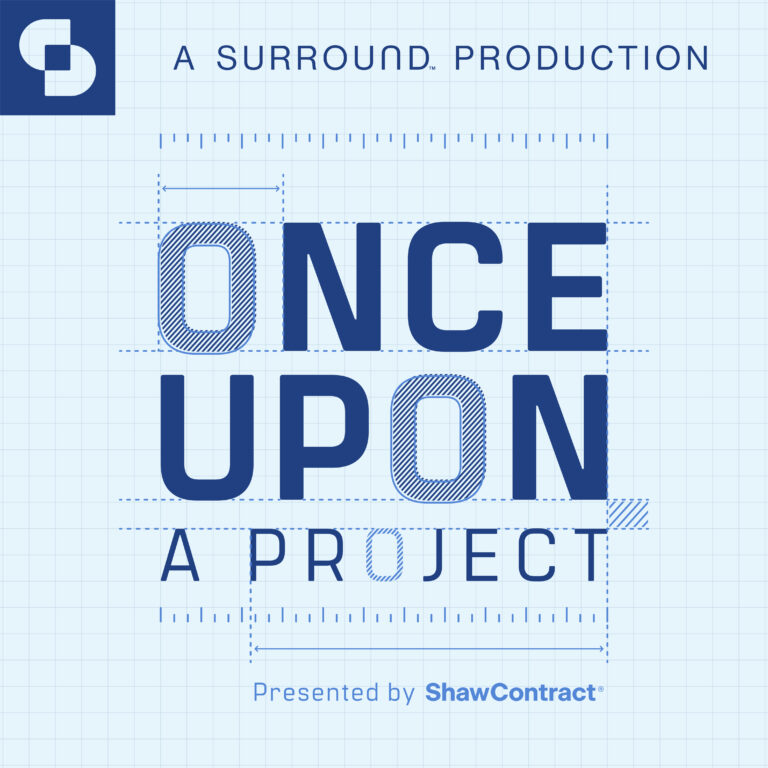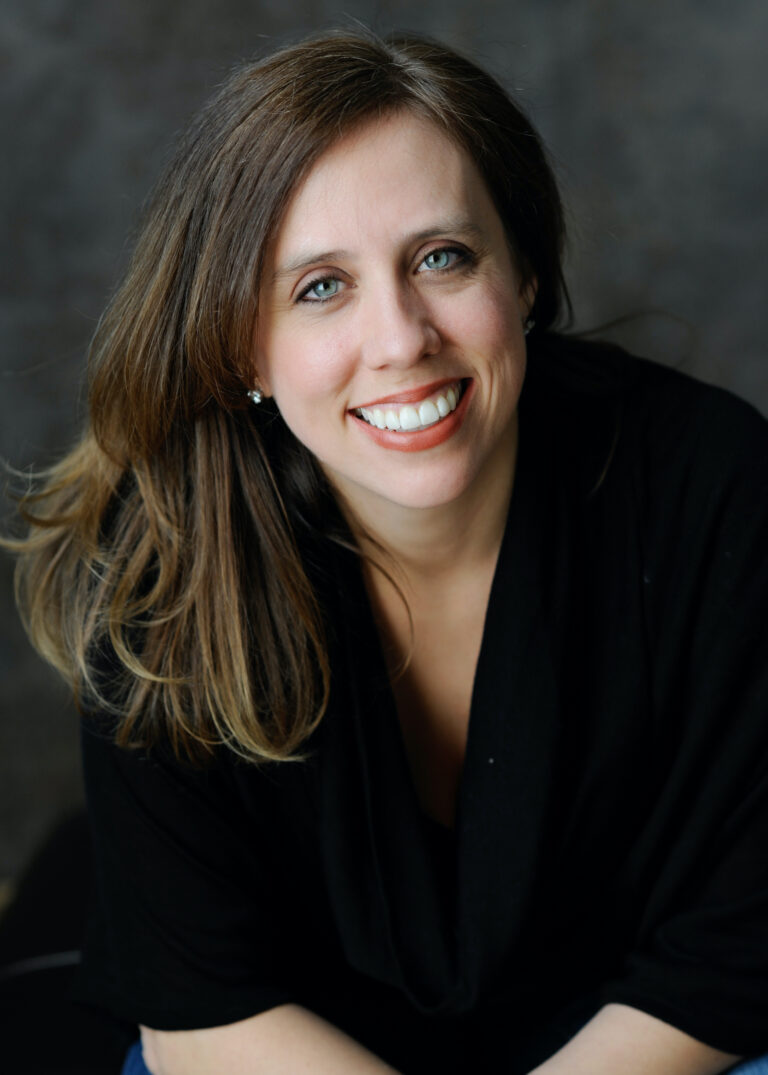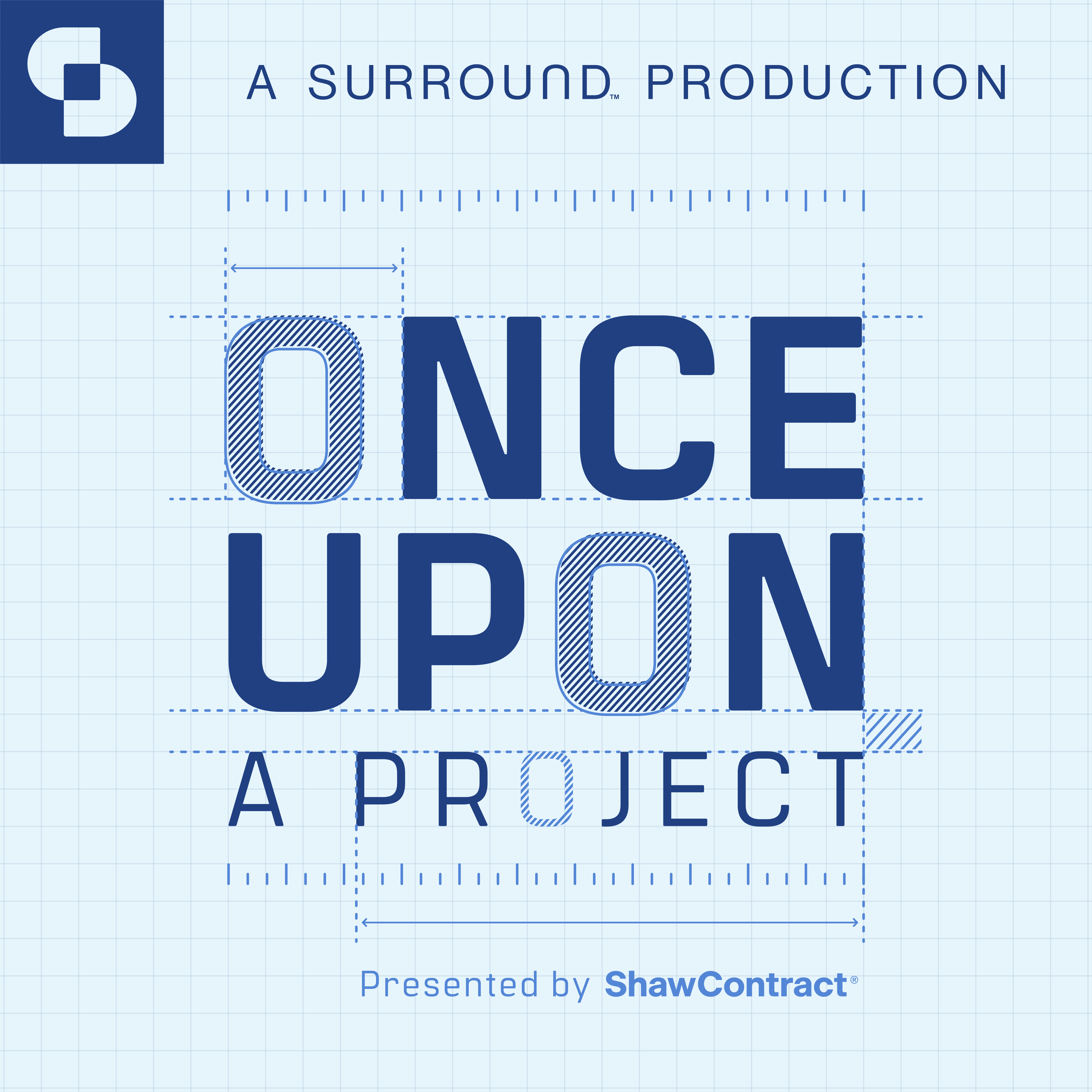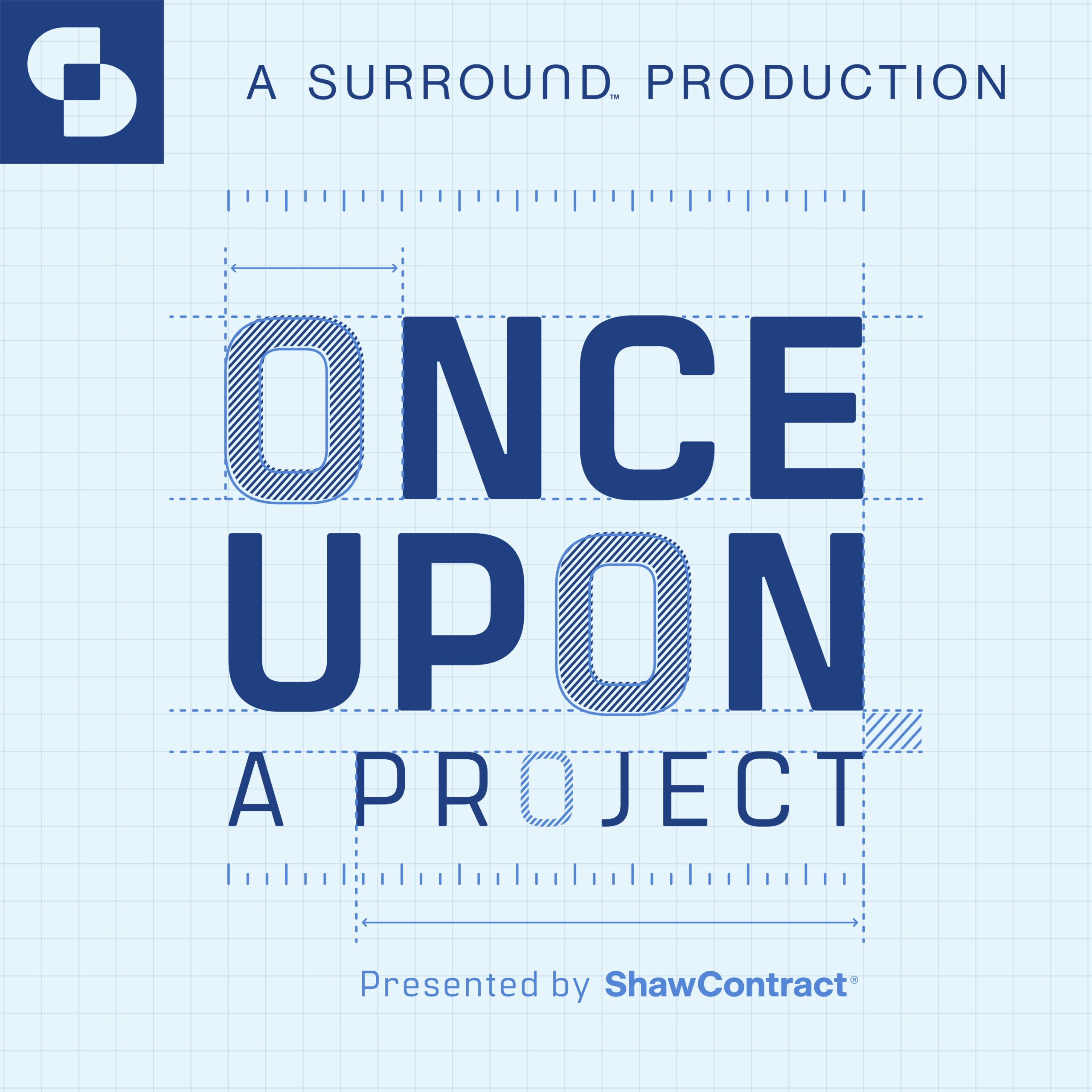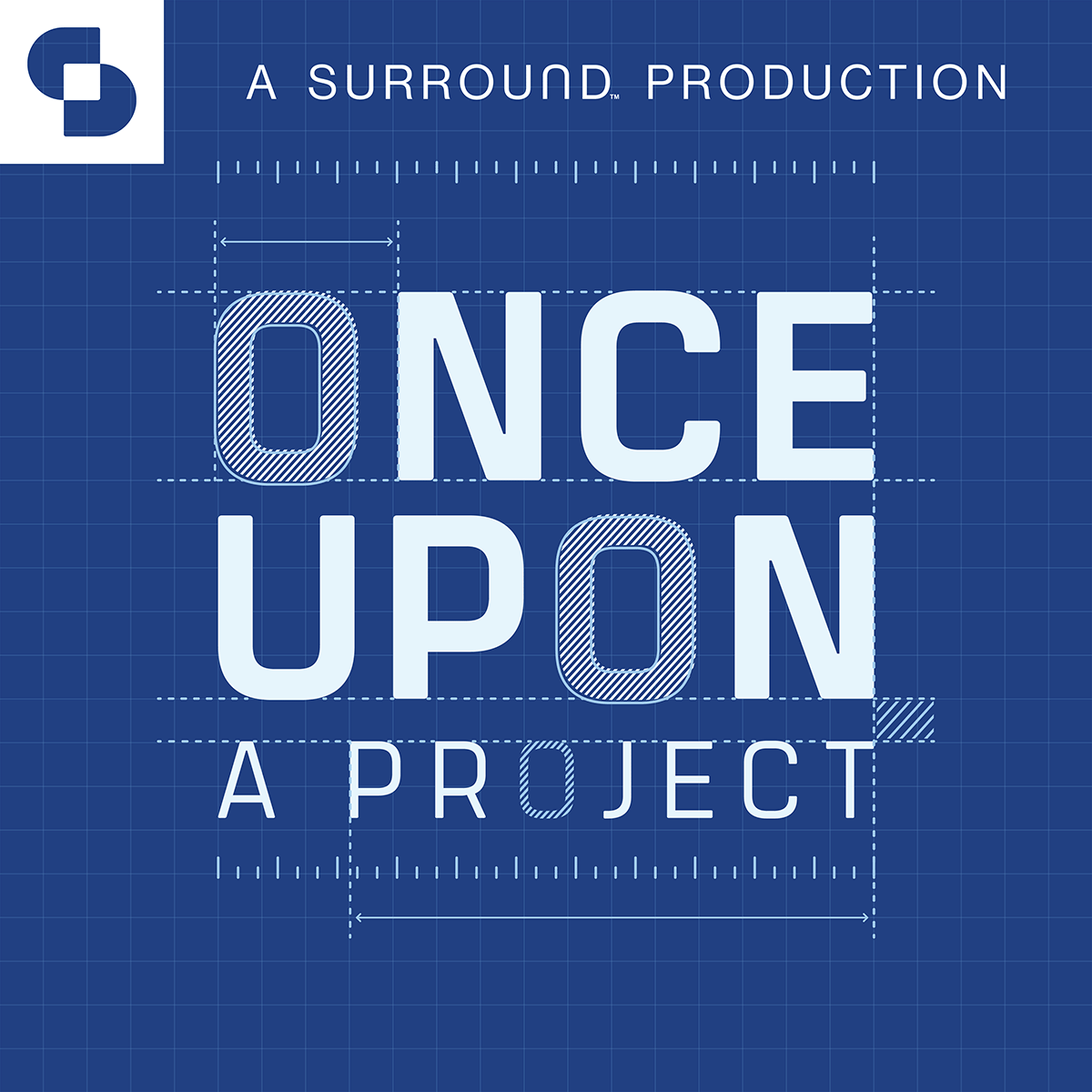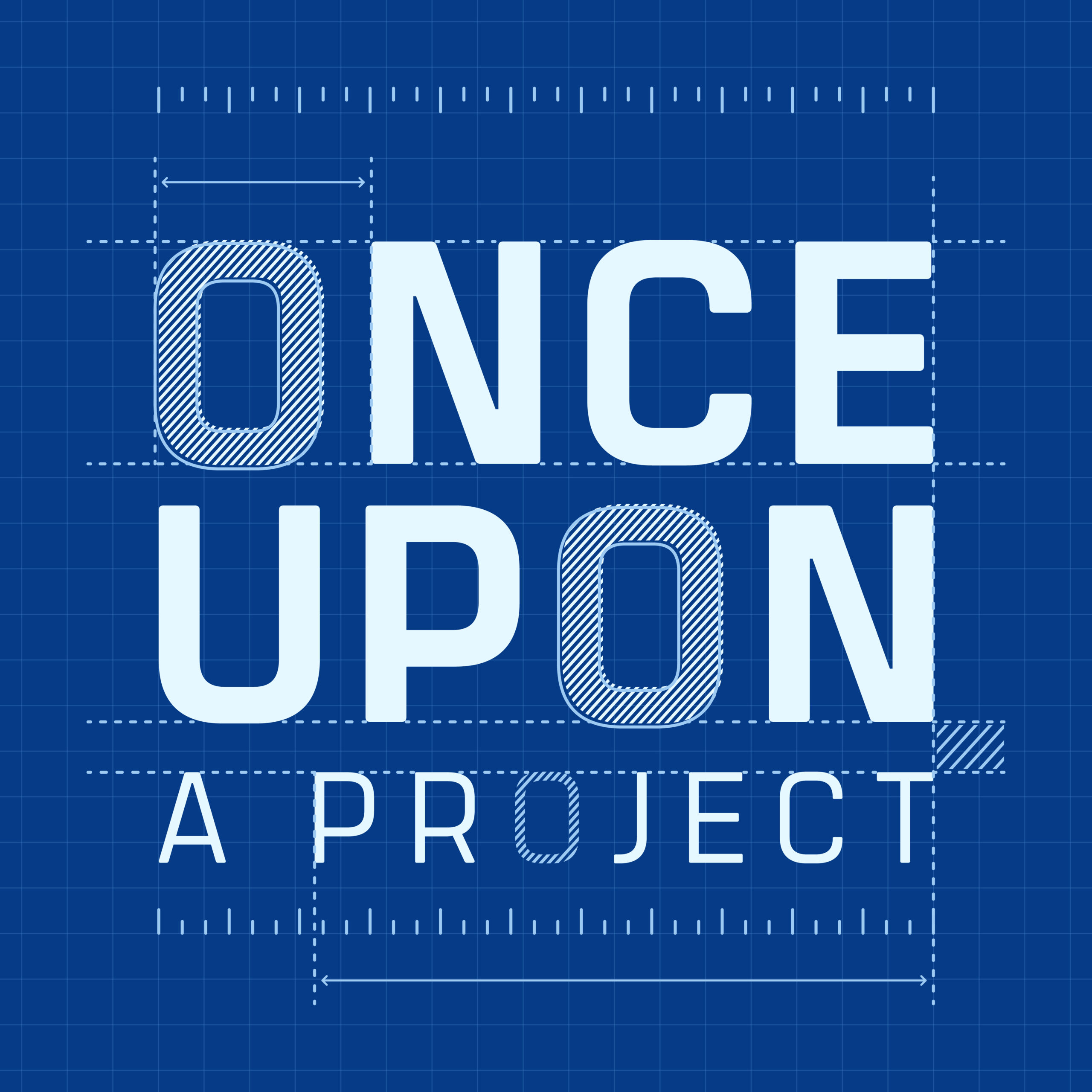David Levo, Principal at ZGF Architects, describes his experience collaborating on a redesign of General Electric’s global leadership training location in Crotonville, New York, during his time with Perkins Eastman. In a project that was at the intersection of workplace, education, and hospitality design, the teams worked together to ensure that the built spaces were an extension of the global strategy and curriculum of the training process “Reimagining Crotonville,” facilitating human connections and aspiring to change behaviors through those spaces.
Once Upon a Project is a member of the SURROUND podcast network. Check out more architecture and design shows at surroundpodcasts.com.
AJ Paron: [00:00:00] Welcome to Once Upon a Project, from the Surround Podcast Network. I’m your host AJ Paron, Design Futurist and Executive Vice President at SANDOW Design Group.
Today we have the distinct pleasure in hearing from my good friend David Levo.
I met David about seven years ago, on top of a mountain in Park City, at a summit for the American [00:00:30] Society of Interior Designers. After chatting with him for about five minutes, I gathered he was a kindred soul of design and adventure, and I secretly hoped we’d be lifelong friends.
So, let’s hear his story of one of his favorite projects that blended design, specialties, collaboration, and a lot of adventure.
David Levo: Hi. I’m David Levo. I’m an architect. I’ve been practicing for 20 years, and I’ve been focusing my [00:01:00] practice around how humans learn and conduct research in the world of higher education.
AJ Paron: And here is the first question that got me into trouble with David. Knowing the type of work that he does—really about research and programming about education—I asked him, wasn’t he really an interior designer, ‘cause usually that’s what an interior designer does. And he said, no, he’s an architect.
David Levo: Although don’t ever ask me where the vapor barrier goes. [00:01:30] I just play an architect on television. Uh, I don’t know, there’s something about a warm side in vapor barriers, but it changes on my climate. I don’t know.
You know, you get friends at dinner parties and they’re like, “Hey, okay, so I’m thinking about renovating my kitchen.” And there’s things about like, Joe can talk to me about studs and queen studs, king studs. I don’t know. I am not the person to answer any of those questions.
AJ Paron: So, you can see where this is already going: David Levo doesn’t fit the mold in anything he does. And just like I had a hard time finding the right professional label [00:02:00] for David, I had an even harder time trying to categorize the project he’s going to talk about.
Let’s just say it’s a little bit of everything.
David Levo: So, today I’m gonna talk about one of my favorite projects, and it is work that I did about 10 years ago for General Electric. And it was their Crotonville Global Leadership Training Process. And it’s as much about a campus—mainly north of New York City, but sort of also spread around the world—but it’s also really about these sort of key moments that [00:02:30] the leaders at General Electric—anywhere from people three years into the company all the way up to the CEO—how they take their next step, right, and reimagining through these experiences, and was this really kind of amazing and powerful moment to learn from how they were doing. It’s kind of like a crash course and a mini-MBA.
We had been doing work at GE with the corporate interiors—sort of reimagining some of their, sort of, for the capital group and a couple of other groups—and we were invited to-to submit for this.
[00:03:00] Now, I had personally not been working with GE directly, but my interest in higher education and how humans learn and interact with each other, the team was like, “Hey David, you know, why don’t you join in? Because there’s this whole education component. It just happens to be a corporate client, but it’s actually more akin to higher education than it is, sort of, workplace.”
So, there were a couple other teams, obviously we were competing against, and we did this thing in the room where we had a lot of design work and we had big poster boards and, you know, a PowerPoint, naturally. And [00:03:30] we all, sort of, started very formally up with, you know, at the beginning, in the front of the room with the presentation behind us. And then as we moved through the process—and this was intentional—we sort of like started to invade their territory in the conference room. And at one point we were actually, sort of, sitting on the table with them while they—it was-it was kind of hilarious.
But, um, we-we were trying to sort of play to this idea of, like, comfort and how it was that we were gonna respond to them because we knew there were gonna be a lot [00:04:00], a lot, a lot of meetings and a lot of engagement. The strategy component was, for GE, about as important as the actual architecture and interiors component of the project.
And so, we knew that they needed to feel really comfortable with us. And it was really successful. It was funny, after we got the-the project—which we were elated—they definitely were like, “Oh yeah, no, we knew what you were doing.”
AJ Paron: It’s pretty clear why the team asked David to join. Education in itself can be viewed as very formal, with strict rules and [00:04:30] regulations. But to effectively engage in learning, it helps to have someone to think outside of the box, and it probably doesn’t hurt if he comes with a big personality.
David Levo: So, the project was focused on the Crotonville campus, primarily for GE, which is about 40 minutes north of New York City on the Hudson River Valley, but it encompassed all of their campuses. And so, it included, a campus in Bangalore, a campus in Shanghai, a campus in Brazil, and [00:05:00] the campus in Munich.
And what our focus was, I and the team were kind of coming in on a, sort of, physical environment perspective. We were teamed with another firm called Prophet, as in to Prophesize, and they were focusing on user experience. And then there was a third group, which was from a Swiss business school, that was focused on reevaluating and reinventing the content.
We were hired to, sort of, reimagine what the facilities might need to be, sort of, doing a gap analysis in terms of what they had [00:05:30], what they wanted to do. We had to dig into the existing curriculum, and then we were simultaneously engaged with the other two groups around what that reimagining might be.
In fact, the process was called Reimagining Crotonville.
The campus north of New York was this old farmstead, really beautiful lawns, kind of looking out over the Palisades and the river. So just absolutely bucolic. And it had an onsite guest residences, where the participants would come. It had a small farmhouse, which was called the White House, [00:06:00] which was the original spot and had two different bars in it.
I mean, they’d put these people in business class airfare from all over, you know—okay, maybe not Connecticut, they’re driving in from Connecticut—but you know, if they’re coming from Bangalore or Shanghai or anywhere in the world that GE operates—‘cause you know, it had at the time around 300,000 people—and it was, they might be the only time that these people would ever see each other in person.
AJ Paron: So, let’s just stop and recap for a second what’s going on on this project.
There are three [00:06:30] separate teams that are all working at this at the same time. Two of them are focused on strategy and curriculum and process, but David’s primary focus was on the structures and the built environment. His job is really to make sure that those buildings, those structures, are an extension of the process that they’re trying to facilitate.
David Levo: There were probably three major initiatives that we were doing at Crotonville. [00:07:00]
One was a new residential building that was gonna completely expand the capacity of Crotonville to have throughput from a training perspective, as well as to contemporize some of those facilities.
Another was these little boutique buildings that were like farmhouses, an old barn that was being converted into an artist loft and a studio that—
There were other buildings where, actually, we put in a team culinary studio. And I mean, so we [00:07:30] were really like people learn in a lot, a lot, a lot of different ways. Cooking’s a really challenging one. Some people really enjoy it. Some people are very uncomfortable by cooking and having particularly cook in front of others. We were providing all of these different experiences.
AJ Paron: Wow. When I think about learning space, the thing that didn’t come to my mind was a culinary studio.
This is a lot of work happening all at the same time. What a huge job to create curriculum, experience, and space to transform GE leadership and employees. [00:08:00] So where did David and the team really need to focus?
David Levo: The project probably had two different goals, complementary to each other. One being building up these knowledge networks and social networks and trust networks across the-the vast complexity of General Electric.
But I think the second one was also to really help their leaders move past what might be some of these emotional roadblocks, so that they could take their next step.
The process was called Reimagining Crotonville. [00:08:30] It was a little bit like bootcamp, like corporate bootcamp. When you got to the sort of the middle of that ladder, you know, congratulations. Everything that you’ve been doing in your career has led you yet again to this wonderful next step.
And so, they had, you know, this whole variety of different kind of experiences that would sort of march through people’s careers and time at GE. And um, the idea, though, was that through those experiences, but particularly the social components that happened—the White House, the little farmhouse [00:09:00] was really sort of the anchor of a lot of those—would be that you could meet another person very quickly and be like, “Hey, I wanna do business with that person.”
They might be in a different subsidiary, what have you, but they wanted to, I’ll pick up the phone and I’ll call them, or maybe they know somebody else who knows somebody. And you started to get these like six degrees of Kevin Bacon right across GE. It’s like this idea of this lateral network that didn’t have to have this complicated technology.
I mean, and this was back before social media was really [00:09:30] blowing up like it has over the last decade. This was a really, sort of, I think what like low fidelity kind of way of connecting humans and really making these impactful things that would hopefully endure.
We were definitely trying to change people’s behaviors through space.
And we were doing that in a couple different ways. Some of it easier than others. This was, what, 2010, 2011, and we wanted to sort of like flip up the learning environments. [00:10:00]
GE’s thinking was, “We’re spending all this money to bring people from all over the world to meet each other in this really beautiful setting. What we don’t want them to be doing is sort of like zoning out, watching a PowerPoint.”
This was all about human connection, right? ‘Cause it goes back to that trust building network.
Fundamentally, it was all about network effects. Maybe it was the rouse, the Trojan horse was like, “We’re gonna teach you something.” But it was really about humans connecting with other humans. And so, it was like this space that really, really put [00:10:30]people connecting with other people, and the visual sight lines, sort of, front and center.
AJ Paron: Connecting with humans. The network effects. Trust building network. After living through almost three years of a pandemic, we now look at these terms with almost nostalgia. But the bigger the organization, the harder it is to have those types of relationships, and there is value in being together.
But as an expert in learning, David knew that there’s more to relationship building than just bringing [00:11:00] everyone together to one location, and that’s that. Design is about facilitating different connections through a variety of spaces. And David understood just how to do that.
David Levo: Other things were like, there was, you know, 80 to 120 people that could be in that particular room, but it needed to be complemented with all these spaces where they could have breakouts.
As we know how conference rooms, you know, I mean the pandemic put us in a little of a pause spot when it comes to conference rooms; pre pandemic, find me an office [00:11:30] where somebody felt they had enough conference rooms there. It doesn’t exist, right? Um, and-and you still get that complaint now, even with these like half empty offices. People like, “Yeah, I know, but the conference rooms.” So, we needed to really expand that complement of those, sort of, small scale collaborative spaces.
And we were playing with what’s called pulse format, where you’re sort of going from a big number of people out into small groups, and then back into the big group for that to sort of report out.
So, groups needed to be able to isolate if they felt [00:12:00] that that was important. GE wanted to offer choice to the groups. So, if it was a sunny day, was there space to go out and maybe sit under a tree? If it was a rainy day, if it was winter, was there fireplace that you could be near?
And so, definitely a lot of that hospitality thinking in a way that in traditional educational environments, you just don’t—it’s normally not front and center. And getting back to that idea again around behavior change, and this 10 years later makes a lot more sense, right?
Like, when we think about the open office [00:12:30] and co-working environments and such, where there’s been a lot of learning in terms of the—how do you balance loud spaces and quiet spaces, spaces for introverts and extroverts, et cetera. But back then, that intersection of workplace, education, and hospitality, there wasn’t nearly as much of that. And it was sort of really exciting to have to answer those questions from those three very different angles.
AJ Paron: From the way David describes it, the GE Crotonville campus sounds beautiful. [00:13:00] I mean, the Hudson Valley is one of my favorite places to visit. But wait, this is a global project, and that adds a lot of complexity.
David Levo: One of the big questions that-that GE had been really wrestling with was are-are we a global company working globally? Or are we a big American company that just happens to be working globally?
Right. And-and so they were trying to, sort of, get people past emotional roadblocks [00:13:30] as leaders of like they sit there and be like, “You know, well that regulatory environment, it’s just not gonna, it’s not gonna change.” And GE was like, “Well go through an exercise to try to figure out how actually it could.”
AJ Paron: And this is where it gets really interesting.
David Levo: So, you’re asking about what was maybe some of the more weird things that happened over this journey with GE.
Well, some of it was like directly related to the project, but probably the ones that are more interesting are the ones that were, sort of, on the margins of a project, [00:14:00] like riding on the back of a police motorcycle in Bangalore, um, off into the distance on this big trip that we were doing across, around the world in like 10 days, which was nuts. And they were like, “Oh, yep, there it goes David. He’s dead. We’ll never see him again.”
Uh, it might have been the time that in the evening—I had never to Shanghai before—We were staying out by where the research park is that GE had its facilities, which was not in the city center. And I was like, “Well, hell. [00:14:30] No offense to suburban office parks, but suburban office parks and research parks are all the same, and they’re not that much fun, and I wanna see Shanghai. And so I, like, got on the subway in Shanghai, which I had never been on, and I’m like, “I’m gonna go into the city center. Who wants to come?” And they were like, “No, no.” And then, like, the group was like, “He’s going to a disco. He’s gonna go out. He’s gonna drink, and he’s gonna dance until the wee hours of the morning.” And then they got—they started to like—I got a lot of text messages like, “Where are you? Are you okay? Are you fine?” Right. [00:15:00] “Come back. We’re having wine in the hotel.” Right? And I’m like, “I’m on whatever big road, the pedestrian street is where everybody goes and walks late at night, and it’s like the Times Square of Shanghai.
But it was this hilarious adventure, and it was just so much fun.
Or, oh God, there’s this picture of me riding a bull—like a plastic bull—in a Marriott in the lobby in Munich. And, at one point, like, we were with some of the GE team, you know, and we were having fun. It was, sort of, the end of the trip, and we had maybe had a little bit [00:15:30] of wine, and somebody had to distract the security guard ‘cause we were like, “Somebody needs a picture on top of this bull.”
And so, somebody went and distracted—was the decoy—and then somebody else had a, had the camera. And then I kind of went and did a running start, uh, and to launch onto this, like, full-sized bull, right?
As we quickly discovered, the bull was not made of metal. It was made of plastic, and it was not anchored to the floor like you would’ve thought it would’ve been but was just sitting there. And so, when I leapt onto the bull, the bull went with me [00:16:00] as I sort of just, you know, somersaulted past it. It was, uh, that was a good time.
The bull survived, as did I. Um, no plastic figurines were harmed in the making of this picture. But then the security guys definitely, they were like, “Uh, what’s going on over there?”
It was my work profile photo for a long time. It was pretty epic.
But it was like that, I think, in terms of the surprise. You know, I think it was like this camaraderie you don’t normally ever get. I mean, you can get along with clients, [00:16:30] right? And, and you, you know, a lot of, lot of clients you have like these very long relationships over long periods of time doing a lot of different things, but this was, sort of, like coming together in this very intense experience and-and sort of creating this thing. And I think some of that came out of just the-the crazy big questions we were all asking ourselves. But then also knowing that we also just, it was good to have some fun along the way.
AJ Paron: Well, as you can hear, David is not shy on any amount of fun. I think if he had designed my school, I would’ve begged [00:17:00] my parents to go early every day, and I’d probably be a lot smarter.
So, getting back to the design of the project, as the team had to reimagine all of these spaces, how did they accomplish the optimal environment GE was looking for?
David Levo: It gets back into that-that intersection of, sort of, workplace, education, and hospitality. You know, we were trying to reimagine the content and the environment that-that the formal education was happening in, [00:17:30] and so those are the classrooms, both big and small.
The workplace component was changing in very much the same way that workplaces around the world were, and have continued to change, which is that-that sort of didactic of like, “Here’s your desk, you know, it’s you’re address. This is what you do. You come in at a certain hour, you do your thing, you leave, right?” Like those days are gone. They’ve been gone for a while. But the physicalness of that and is very different. [00:18:00] But I think we still are wrestling with, and-and probably the pandemic is really highlighted how much work we still have to do on the behavioral side of all of that.
And, you know, why are you coming together? Because there’s that value proposition that the employer has to make that, and then that, that gets to the hospitality component to it, right? Because that’s, in some respects, the secret sauce, because hospitality has always been focused around experience, particularly at the high end.
And so how do you graft [00:18:30] that, sort of, behavioral and experience consideration from the world of hospitality, and plow it back into workplace, plow it back into learning experiences? And so, in a way that there’s not one silo of those three things. It’s really, actually, everything is a learning space. Everything’s a working space. Everything’s an experience. And this just becomes this diversity of places that as you, as a participant, wandering around one of these campuses, you could choose, you know, [00:19:00] basically getting back again, like, “How’s the weather? What time of year is it? You know, how do I feel? Am I an introvert? Am I an extrovert? Am I an extrovert feeling introverted today?’ Right. And that you providing that sort of level of choice, and that level of experience, because, you know, they are really trying to get at the core for leaders—young and established leader—to take these really big questions, right? And, sort of, to prompt them in ways that sometimes can be uncomfortable, but then also are coming out of this-this sort of idea [00:19:30] of trust building. And so, you kind of had to have all three of those things there.
AJ Paron: This was a big project, in multiple countries, with multiple teams working together. Now more than 10 years later, what does David think about the outcome of the project and what they accomplished?
David Levo: The interesting thing was, as it is with any project, particularly one that, sort of, for me is one of my favorite projects I’ve ever done, are the unexpected things, right?
You go into a thing knowing, you know, anticipating certain things, right? [00:20:00] Like, we’re gonna do a strategy component. There’s gonna be this kind of schedule. This is gonna come out of it. There’s gonna be writing. There’s gonna be PowerPoints and renderings, and then at some point documents that something goes and gets built, and maybe even a, you know, post-occupancy, what have you.
But there were some really fascinating things that took, sort of, really interesting detours. And some of those detours were not just my detours as a, as a practitioner working with a client, but it was even their-their sort of detours. [00:20:30] And it was as much an emotional journey for them as it was for me.
Not only was the project itself fascinating, but I got to learn different ways of how humans, kind of, connect with each other, and how GE—which has been doing this for, you know, what, close to a hundred years almost—how it is that some of those lessons learned could actually port themselves over into the world of design and the world of academia, which is my client base. And how it is that sort of, these really weird intersections [00:21:00] of fun client work can actually, sort of, go right back into practice in a way that is very unexpected.
AJ Paron: And my last cheeky question for David, besides all the fun and emotional journeys they had together, was the client happy?
David Levo: I think, definitely, there was this expansiveness to the questions, and I think they felt that-that we had worked through the questions and come up with some amazing and wonderful answers.
You know, did they get to have, did they get to build all those ideas? No, but that’s [00:21:30] probably true anywhere, right? Um, and so, but did what they get, was it impactful and did it change things for them? Yeah, it did.
AJ Paron: While a lot of these ideas and concepts seemed very innovative over 10 years ago, they are so relevant, and they are very much the essence of what we’re talking about in education and in leadership.
David Levo: What’s been the sort of enduring lessons and what’s, what could be applied to our post-pandemic [00:22:00] reality today is we’re all trying to answer like why to come back to the office, right? What does it mean? I think, design and architecture have never mattered more to the human experience, maybe ever than now. Right.
And I think that we now have a population in so much of the world that really does now understand what it means to physically come together. That the physicalness is not the default [00:22:30] that they had necessarily thought it was three years ago.
But what it also means—and I think this is where the lessons from GE really, really are incredibly impactful today—is that that population that understands space in a much more impactful and nuanced way, they’re also an educated consumer now in a way that they weren’t three years ago. And they want to know why, you know, why should I come into the office? Why should I come to the theater? Why should I [00:23:00] hang out in whatever the environment is that you’re trying to convince me that I should be in?
And that sense of choice is really, really important now as opposed to, you know, you have to come here, right? It has to want to be compelling. And as I think about the next decade of my practice, something that I’m really, I think, gonna be focused on is that the physical design and the programming and operations of the design have to be thought through in a synergistic way [00:23:30] unlike how they ever have been before.
And what are the tools that, particularly folks like me who are more on the strategy—the upstream strategy side—and we’re doing the programming and we’re looking at the behavior, like, how do you, how do you measure some of that? How do you help your clients understand the possibility of the flexibility of the behaviors that are gonna happen in that space as opposed to, you know, the stuff that’s more tangible that everyone’s sort of used to.
And I think that is an area where education—not just education as a product or type of a typology of-of design [00:24:00] environment—but education in terms of like what are the words that our clients are using to understand behavior in space, right? We, even as architects and designers, aren’t always that good at it.
It has gotta be accessible, and it’s gotta be a toolkit that-that our users can understand how it is that they’re gonna, from a behavioral standpoint, run and operate the experiences, because they have to justify to their populations why-why is it that people are getting on airplanes to go to Crotonville, Right? Why are people getting on the subway [00:24:30] to come back into the office or enduring the, you know, the commutes? And I think that GE had a lot of that, like, this is how you do the carrot. And that idea of, sort of, thinking about content, environment, and experience, um, from the three consultant teams that were working in synergy with GE itself, were those sort of buckets of workplace, education, and-and hospitality, all kind of, you know, firing on all those cylinders together.
Every project kind of has to do that now.
AJ Paron: To hear more stories [00:25:00] about the design process behind some of the most amazing projects and some really cool designers, make sure you follow us wherever you get your podcasts.
Once Upon a Project is a part of the Surround Podcast Network. You can find our show notes and full transcripts on our page at surroundpodcasts.com. That’s podcasts with an ‘S’.
There you can also contact us if you or someone you know has a great project to share on this podcast. Just go to [00:25:30] surroundpodcasts.com, and head over to the Once Upon a Project page to submit your ideas. I really want to hear them.
A huge thank you to Vornado for letting us use their incredible podcast studio in the brand-new PENN 1 building in Manhattan.
This show is produced by The Studio at SANDOW Design Group. Huge thank you to the pod squad that makes me sound amazing—Samantha Sager, [00:26:00] Wize Grazette, Hannah Viti, and Brittany Lloyd.

